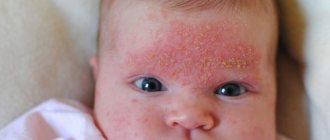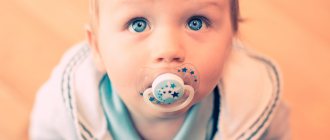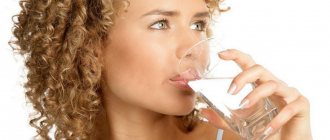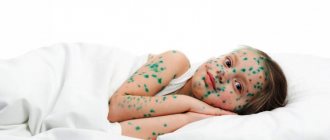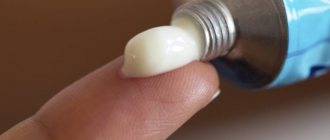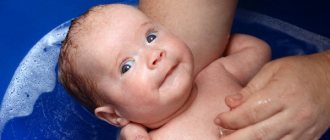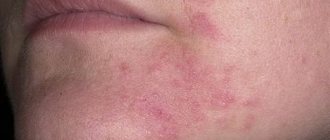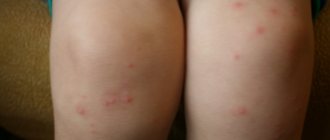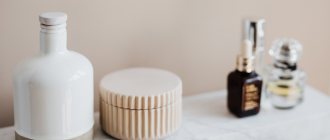The thinner and more sensitive the skin, the more dermatological problems arise. In some cases, a rash on the face of a 1-month-old baby poses a danger to the baby’s health. However, the most common rashes during this period are completely harmless and go away on their own. It is very important for parents to learn to distinguish dangerous types of rashes, to know about various treatment options, so that the child feels more comfortable, sleeps better, and is calmer during waking hours.
Varieties and their symptoms
It is difficult to independently determine the cause of a rash on a child’s face. Pimples can appear at different ages. Some of them are localized on the face. Others can affect the head, neck, and torso.
For an accurate diagnosis, an examination by a doctor is required. The pediatrician will prescribe additional examinations. It is important to pay attention to external manifestations.
A significant role is played by:
- location;
- extent of skin damage;
- the presence of accompanying symptoms (itching, burning, pain);
- size of rashes;
- the presence of inflammation or abscess;
- general well-being.
Experts identify several types of rashes that affect the face. Some of them require close monitoring and drug therapy.
The School of Dr. Komarovsky will tell you about different types of rashes:
Prickly heat
A child's sweat glands are imperfect. Because of this, thermoregulation processes in children do not proceed the same way as in adults. Miliaria is one of the most common causes of rash.
It is difficult to distinguish it from other conditions on your own. Difficulties with differentiation are associated with the presence of several varieties.
- Miliaria rubra. The surface of the skin changes color. In severe cases, it turns bright pink. Rashes form with cloudy contents inside. A red tint to the epidermis indicates inflammation.
- Crystalline prickly heat. A large number of bubbles with transparent contents form on the skin. When touched and pressed, they burst easily. There is no redness with this form.
- Papular miliaria. It manifests itself as a pinpoint rash on the face and body. It can form quite large accumulations on the skin.
- Infected heat rash. This is a complicated option. The diagnosis is made if microbes enter the wound formed when the vesicle ruptures. Bacteria provoke an inflammatory process.
Possible suppuration of the affected area , deterioration of health, rise in temperature.
The rash appears due to problems with the functioning of the sweat glands. Prickly heat can be caused by various factors. The main ones are:
- indoor humidity;
- lack of hygiene;
- excessive insulation of the child;
- use of synthetic underwear and clothing.
Miliaria affects not only the face. Often the rash appears on the neck, armpits, shoulders, and then spreads throughout the body.
If the condition is not complicated by infection, the child feels normal. Pimples do not cause discomfort and do not cause itching.
Miliaria is a disease of newborns. What do you need to know? Watch the video about this:
Allergic reactions
During the first year of life, a baby actively gets acquainted with new foods. After 6 months, it is recommended to introduce complementary foods. Before this, he receives breast milk or formula.
The digestive system continues to develop after birth. Any unsuitable product may cause an allergic reaction. Attentive parents will notice the appearance of a characteristic rash on the baby’s face.
Such rashes are a manifestation of the body’s immune reaction in response to irritants. Among the allergens:
- food products;
- wool;
- dust;
- medicines;
- cosmetics;
- household chemicals;
- pollen.
Most often, allergic dermatitis is observed with the introduction of complementary foods. If the baby is breastfed, then the reason will be a violation of the mother's diet.
A rash caused by food allergens is most often localized on the cheeks and chin .
There may be redness in these areas of the skin, but no pimples. The baby is bothered by severe itching.
People often ask: does Linex help with diarrhea in a child? How and how much to give the medicine? Our publication will provide answers to questions.
Read about the symptoms and treatment of atopic dermatitis in children in this article.
Symptoms and treatment of acute adenoiditis in a child are discussed in this material.
Newborn acne
Not all facial rashes require treatment. Newborn acne goes away on its own.
The appearance of a strong, small red rash on the face of a month-old baby, like pimples, can frighten parents. These rashes are hormonal in nature. Every fifth child is susceptible to their development.
Acne is localized mainly on the face. Pimples cover the forehead, nose, chin and cheeks. Some of them are filled with purulent contents. Dermatologists call them pustules. In appearance they are close to teenage acne.
Acne does not cause discomfort. Pimples do not cause itching. In most children, this phenomenon disappears on its own at 2-3 months. In rare cases, rashes persist for up to 1.5 years. Then we talk about baby acne.
Small white nodules on the baby’s nose or under the eyes should not cause concern. Many babies are born with milia on their face.
These rashes are associated with blockage of the sebaceous ducts . They also go away without treatment.
Doctor Komarovsky's school will talk about rashes in newborns:
Erythema toxicum
Newborn babies gradually adapt to their environment. During adaptation, a restructuring of all body systems occurs.
The child learns to eat and breathe differently.
During the period of perestroika, red pimples often appear on the face; they have gray heads. The rash affects the face and scalp.
Erythema toxicum is not dangerous. The rash goes away within a few days.
Infectious diseases
Older children are also more likely to develop rashes. Parents should be careful, as pimples may indicate an infection.
- Chicken pox.
This is a viral disease, which is characterized by the appearance of red lumps on the skin. Rash on the face and body. The spots transform into bubbles. The latter burst and a crust appears. With chickenpox, your body temperature rises. Possible enlarged lymph nodes. - Rubella. The rash can be either large or small. The child is showing signs of ARVI. Your throat may hurt. Its mucous membranes usually turn red and swell.
Rubella rashes disappear after 5 days. During this period, a slight rise in temperature is possible.- Scarlet fever. When the disease occurs, pimples appear on the face and then spread throughout the body. They are bright red in color and noticeably rise above the skin. The temperature rises, signs of a sore throat appear.
- Measles.
This viral disease is always severe. Pink spots appear in the early stages. The predominant place of their localization is the forehead. Further, the spots merge into large formations . Symptoms other than a rash on the face may be observed: runny nose, cough, diarrhea, headache, temperature rises to 40 degrees.
A distinctive feature of any infectious disease is an increase in temperature.
Children's viral infections are easily transmitted by airborne droplets. The same disease does not develop twice. The child develops a strong immunity to any of the infections.
The appearance of a rash on a child’s body due to allergic reactions
Atopic dermatitis (infantile eczema)
An inflammatory disease caused by allergens and toxins.
Quite common in infants and infants.
Atopic dermatitis appears due to a genetic predisposition to allergies, often occurs with exacerbations and can last until adolescence.
In addition, the cause of the development of childhood eczema can be:
- bad ecology;
- lack of vitamins;
- a large amount of sweet and salty foods in the diet;
- increased emotionality and stress;
- unbalanced maternal nutrition during pregnancy.
Common symptoms of atopic dermatitis include itching, redness of the skin, dry, scaly patches, cracks, bumps and blisters.
In the affected areas, a burning sensation and moist discharge are noticed in the itchy areas.
The situation is aggravated by mental stress, excessive sweating, long hot showers, dust and dry air.
All this, as well as the main types of allergens (food, household, pollen, epidermal), can cause asthma and hay fever.
Rash from insect bites
An allergic reaction after an insect bite develops quite quickly - within several hours, and sometimes in a couple of minutes.
It can be caused by bee, wasp, bumblebee, flea, ant or mosquito bites.
At the site of penetration of the poison, swelling and redness are observed, and itching is felt.
In principle, this is a natural process, because the body tries to protect itself from the influence of a foreign agent, but if the situation gets out of control, the process degenerates into a pathological one, which is characterized by unfavorable outcomes.
Is it necessary to treat the baby and how?
Parents are interested in how to treat a rash on their child’s face. The pediatrician will answer their questions. The treatment regimen is selected individually, taking into account the causes of the rash.
Treatment is not always necessary. Sometimes the rash goes away on its own.
If the rash is allergic in nature, the influence of the provoking factor must be eliminated. A nursing mother should reconsider her diet.
The following are excluded from the diet:
- chocolate;
- citrus;
- Exotic fruits;
- red fruits;
- dairy products;
- spices.
Be careful when including fish and chicken in your diet. They are also considered potential allergens. Each new product is introduced to the menu carefully , observing the baby's reaction.
When introducing a child to new food, strict rules are followed. Your pediatrician will tell you about the specifics of introducing complementary foods.
Treatment of prickly heat does not cause difficulties for parents. It is important to maintain good hygiene. It is necessary to bathe the baby regularly. Decoctions of herbs - string or chamomile - are added to the water.
For severe rashes, antihistamines must be taken. The choice of drug is made by the doctor. Suprastin is most often recommended for children.
To eliminate peeling, you can use healing non-hormonal ointments. The drugs Bepanten and D-Panthenol have good reviews.
If a rash appears against the background of an elevated temperature, you should consult a doctor. In severe cases, hospitalization will be required.
Doctors usually prescribe antibiotics or antiviral drugs depending on the type of pathogen. Other medications are designed to relieve symptoms and make the child feel better.
If you want to know whether it is necessary to remove adenoids in children, read our article.
You can learn about the treatment of diathesis in children from this publication.
What should you do if your child has ear pain and a fever? We'll tell you! Find out more in this post.
How to distinguish infectious diseases from allergic reactions
To protect your child from serious consequences, you need to be able to distinguish fungal or infectious interventions from allergies and know how this or that skin disease manifests itself.
The main difference between rubella and allergies is the presence of enlarged lymph nodes.
Rubella rashes begin on the face, gradually moving to the torso and limbs, and the temperature rises sharply.
An allergic rash appears immediately on all parts of the body, but the child’s condition does not change.
Rashes during measles, just like during rubella, are accompanied by high fever.
A sick child develops weakness and headache, and his voice may become hoarse.
And only after 4-5 days do red spots appear.
Allergies do not take long to develop; the body reacts to it much faster.
Chickenpox should not be confused with allergic reactions - the rash during it resembles blisters with a reddish border, filled with a clear liquid.
One of the most unpleasant and dangerous diseases - meningococcal infection - differs from allergies in the presence of a rash with subcutaneous hemorrhage, and is accompanied by a serious condition of the child - fever, vomiting, severe headaches.
Another type of skin disease is scabies, which is confused with an allergy by more than half of parents.
However, it can also be distinguished - scabies itch bothers you mainly at night.
It is at this time that the mites that cause the infection become most active.
The same allergy symptom accompanies the baby throughout the day.
In addition, scabies does not cause a runny nose and watery eyes, which are characteristic of allergic diseases.
What not to do
Parents find it difficult to cure the rash. Therapy can indeed be lengthy. However, compliance with a number of requirements significantly speeds up treatment. The doctor will tell you what not to do when getting rid of the rash.
It is unacceptable to squeeze out pimples that appear . This does not affect the rate of healing, but will open the door to infection.
Rashes in newborns should not be treated with alcohol-containing liquids. Their skin is too sensitive. This may cause a burn.
Overheating must not be allowed. The thermoregulation system is not formed. Therefore, the baby is dressed so that he does not feel hot. It is better to use vests and diapers made from natural fabrics.
These are instructions for parents on what to do if their baby is a month old or older and has a rash on the face, around the mouth or on the head, arms and stomach.
If any rash appears, it is better to show the baby to the pediatrician. This will eliminate doubts about the correctness of the diagnosis. If necessary, the doctor will order tests and recommend medications.
Impetigo
Acute bacterial infection of the skin of the face, hands and feet. Streptococci or staphylococci enter through small cuts on the body. Pathogens can be transmitted through direct contact, towels, and toys. Ulcers and pustules appear, when they burst, leaving the typical honey-yellow crusts. The characteristic symptoms of impetigo most often occur around the mouth and nose. The rash itches.
Impetigo is treated with antibacterial ointments; if the ulcers do not heal, the doctor prescribes oral antibiotics. It is very important to maintain hygiene and cut off overgrown nails on your child’s hands. You should not touch the ulcers; impetigo is a very contagious disease.
Hormonal rash
This is a small, small rash on the face of a baby. Another name is acne. Rashes may appear when the baby reaches 2-3 weeks of age. Locations: on the forehead, cheeks or chin.
The rash does not pose a threat to the health and life of the baby, since the causes of its occurrence are not related to pathology. Acne occurs due to hormonal changes in the baby's body. The rashes change the relief of the epidermis and do not have a purulent center, since they are not accompanied by blockage of the pores.
What to do if acne appears in infants? This problem does not require therapy. No local or general treatment is required. The formations go away on their own when the baby is 2-3 months old.
It is not recommended to use even lotions prepared on the basis of medicinal plants. Any means can harm the baby’s epidermis, injure the skin, and also provoke allergies.
Necessary therapy
General therapy includes four sequential steps:
- The allergen is eliminated.
- The body is cleansed.
- Medicines are used.
- A special diet is prescribed.
The causes of rash in newborns are described in this video:
In case of a food reaction, the allergy trigger must be removed from the body. This is done with a laxative and plenty of drinking water. In the first two days after the rash appears, a special hypoallergenic diet will be effective.
If urticaria is chronic, therapeutic measures are aimed at pathologies of the digestive system, and tests for parasites are also required in order to prescribe antiparasitic measures, if necessary.
Folk remedies
You can use folk remedies only if the child does not have symptoms indicating angioedema. Using decoctions, infusions or compresses, you can reduce the discomfort of symptoms.
You can use one of the following methods:
- Aloe juice lotions: the fleshy leaf is crushed into a pulp so that enough juice appears. The pulp and liquid are applied to a cotton swab, which is applied to problem areas of the skin for 10-15 minutes. You can use fresh cucumber instead of aloe.
- Decoction for applications: add a tablespoon of a mixture of dried calendula and chamomile flowers to a glass of boiling water (200 ml). Leave for one hour, then strain, soak a bandage or cotton pad. Apply to allergic spots.
- Bath: 3 liters. 200 grams of marjoram are brewed in boiling water. Leave for about an hour, cool to room temperature and strain. Add liquid to the bath, and the child should bathe for at least 15 minutes.
- Cold compress: a teaspoon of propolis tincture is diluted in half a glass of cold water. A bandage is soaked in the resulting liquid, applied to the affected skin and wrapped for 30-40 minutes. Repeat every day.
When choosing components, it is worth considering that some of them can also be allergens; the individual reaction of the body is taken into account.
